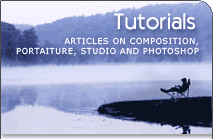This article belongs completely to Ed Shapiro, a professional photographer, who contributed a lot to the art. It is based on the content of a topic of forum. I have to thank Ed for covering this topic. I could not find any place where Ed gathered and published his knowledge, so I decided to extend the audience of the forum where he posted this topic. So here it goes...
Set Exposure By Aperture Or Shutter
Question:
What should I do:
- Set my lights up and then meter to the lights? or
- Set my Aperture value and Time value and then adjust my lights to that?
Because you should know what exposure you want for the desired result your after. If you do #1 — you are simply at the mercy of what ever random setting and distance the lights may be at. The desire is to create images (by knowing our equipment and our craft).
Like a cabinet maker selects the proper diameter drill bit he needs to make the desired hole. Rather than just using the drill with what ever bit is in it and lives with whatever hole size was the result.
One way he will get what he wants, the other way he may get something that will work, but more likely will botch the job due to not knowing what he was doing (which will also be the case for photographers who do #1 instead of #2 above.
When I setup a shot, I pick the exposure I want to get the results I'm after. Then I set my equipment (lights/camera) to give me what I want.
For example, if I'm going into someone's home to shoot a large group, I want a lot of DOF so I may want F11. I'll set up two lights (main/fill) and meter them so that I get the F11 I desired. If they are not powerful enough, I move them closer until I get what I want. If I can't get them close enough, then I may make a trade off and use F8 (experience judgment for the situation). If I'm forced to use F2, I better come up with some other solution, because the shot won't be any good.
If I'm shooting a single portrait of someone on location, and don't want a lot of DOF, I may pick F4 in my head for my desired results, then set up the light(s) one or two and meter them until I find I have them set at F4. I then setup the subject and shoot.
With what I have been shooting so far I set up my lights and then adjust Av and Tv to the lights by choosing a F-stop and then metering to find the Tv.”
Of course you know that Tv (is that shutter speed?) doesn't matter when using lights (strobes) as only the F-stop is used to control exposure from the strobes. To keep things simple, just always set your shutter speed (Tv?) at 125th and use your f-stop to set your exposure from the strobes.
Now to go a step further, if you "want" to include ambient light in the shot, you now can adjust Tv to drag the shutter to allow ambient light into the shot (ambient light coming in windows, from lamps, etc.) Outdoor lighting will be the same color as your strobes. But including lamps and incandescent bulb light in the shot will introduce a yellow color (sometimes desired, sometimes not desired) which one will depend on if you drag the shutter at all or a lot. A slower shutter speed will allow the ambient light into the shot — thus allowing the background to remain light instead of dark (if the strobes light falls off back there) or allowing ambient light to become 'fill light' in the image.
Or to confuse the issue even more, the ambient light can be fill light, or you can use a window and it's ambient light as the main, and setup a strobe to be your fill on the shadow side (not likely — but it can be done)
F-stop is used to set the exposure for the strobe lights. Shutter speed is used to reduce the exposure to exclude ambient light or to lengthen the exposure to include more ambient light. ![End of the article [end of the text]](http://www.romanzolin.com/img/misc/text_end_ed.png)





